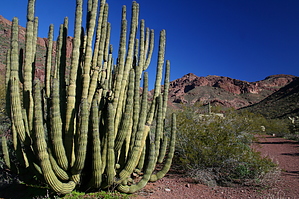| Guide | ♦ | 17 Triplogs | 1 Topic |
details | drive | permit | forecast | route |
stats |
photos | triplogs | topic | location |
| 270 | 17 | 1 |
Remember the Alamo! by Randal_Schulhauser  Some History: On a recent trip to Organ Pipe National Monument, our "Plan A" objective was to check out Puerto Blanco Drive. This 50-mile loop drive to the west of Hwy 85 appears in many 4WD Arizona Guides. Unfortunately, it has been closed for at least five years (I don't know if this is in response to the death of Ranger Kris Eggle - "Kris Eggle was shot and killed in the line of duty at Organ Pipe Cactus National Monument, on August 9, 2002, while pursuing members of a drug cartel hit squad who fled into the United States after committing a string of murders in Mexico. He was 28 years old."). The visitor's center is now named in honor of Ranger Kris Eggle. Some History: On a recent trip to Organ Pipe National Monument, our "Plan A" objective was to check out Puerto Blanco Drive. This 50-mile loop drive to the west of Hwy 85 appears in many 4WD Arizona Guides. Unfortunately, it has been closed for at least five years (I don't know if this is in response to the death of Ranger Kris Eggle - "Kris Eggle was shot and killed in the line of duty at Organ Pipe Cactus National Monument, on August 9, 2002, while pursuing members of a drug cartel hit squad who fled into the United States after committing a string of murders in Mexico. He was 28 years old."). The visitor's center is now named in honor of Ranger Kris Eggle.Always having a "Plan B", we decided to check out Alamo Canyon. "Alamo" means "cottonwood" in Spanish. The presence of cottonwood trees is always an indicator of a nearby permanent water source. Early southwest homesteaders used these trees as a general indicator of land ranching potential. Bill and Birdie Miller came to the Sonoran Desert to homestead in the early 1900s. Substantial stands of cottonwood trees combined with flowing water in the upper reaches of Alamo Canyon convinced the Millers that this would be a successful location for their homestead ranch.
Later, the Robert L. Gray family purchased the Alamo Ranch, adding to their extensive holdings within the Organ Pipe boundary. All ranching within the national monument came to an end in the mid-1970s with the death of the Gray brothers, Bobby and Henry. Evidence of this ranching history can still be traced within Alamo Canyon and Bull Pasture. Grinding holes used by Native Americans predate the homesteaders. These can be located in the slickrock along the Alamo Wash. A cluster of grinding holes exists near the corral remains. The Hike: The Alamo Canyon trail head has parking for half a dozen vehicles near the primitive campsites and pit toilet. There is no water available at the trail head. On this particular day the only other vehicle at the trail head was manned by the local Border Patrol. The trail dips immediately into the Alamo Wash and joins the old double-track leading to the ranch ruins. The Ajo Range frames your view. Lush stands of organ pipe cacti line the trail like sentinels. As you walk the trail your ears become attuned with nature. You pick out the songs of various birds. You hear the water trickling in the nearby brook . You hear no sounds of civilization - bliss... After trekking a little under a mile, you happen upon the remains of the Alamo Ranch House . This was originally constructed in the late '20s by the homesteading Miller family. You can also find evidence of an adobe foundation on the west side of the structure. This was the first Miller house built near the turn of the century. Continue upstream about 100 yards crossing over to the south side. You soon see the corral . The concrete cattle trough dates the remains with a cornerstone indicating "1935". Evidence of this past inhabitation is furthered when you happen upon some trash dumps . When you leave the old corrals and head back into Alamo Wash, there is a large slickrock area. You'll notice a dry wash heading to the north. We elect to continue east following the flowing stream. You'll notice grinding holes in some of the exposed slickrock. I'm not sure how old these grinding holes are. We head upstream about a quarter-mile from the corral before turning around. It is possible to continue off-trail from here but elected to head back. Summary: The Alamo Canyon Trail is an unexpected gem within the Organ Pipe National Monument. I'll go so far as to state the best examples of organ pipe cacti are located along this trail. Enjoy! Organ Pipe Cactus NM NPS Details 10/24/08 Ranger Vivian Sartori writes: We have never found any evidence of cottonwoods in Alamo Canyon. How the canyon was so named is a bit of a mystery. The nearest cottonwoods are at Quitobaquito, 30 raven-miles away. Check out the Official Route and Triplogs. Leave No Trace and +Add a Triplog after your hike to support this local community. | ||||||||||||||||||||||||||||||||||||||||||||||||||||||||||||||||||||||||||||||||||||||||||||||||||||||||||||||||||||||||||||||||||||||||||||||||||||||||||||||||||||||||||||||||||||||||||||||
 Route Editor
Route Editor




